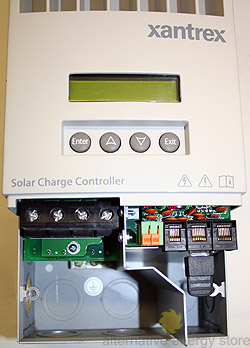 Build #2 The second build was a success. It was based on the Instructables guide by the author "tinkerme". After reading the guide, I had a hankering to try again.
Build #2 The second build was a success. It was based on the Instructables guide by the author "tinkerme". After reading the guide, I had a hankering to try again.
**Parts List**
Hot side:
- a passive aluminum heat sink from a Power Mac G4 466
Hot side:
- a passive aluminum heat sink from a Power Mac G4 466
 It's roughly 3" wide by 6" long, lots of fins. The raised part for the chip, was cut off with a hacksaw and ground down. Upgrade: concerned the heat was slipping through the outside fins. Put a shroud around the hot side of the cooler. This would prevent the loss, and gather the heat. Found an aluminium control box from a washing machine. The shroud also prevented the heat from reaching the Thermalright cooler fins.
It's roughly 3" wide by 6" long, lots of fins. The raised part for the chip, was cut off with a hacksaw and ground down. Upgrade: concerned the heat was slipping through the outside fins. Put a shroud around the hot side of the cooler. This would prevent the loss, and gather the heat. Found an aluminium control box from a washing machine. The shroud also prevented the heat from reaching the Thermalright cooler fins.
- little 1-1/2" x 1-1/2" square piece of copper. It was used as a spacer/transfer sat of heat to the peltier module. Use a copper pipe, cut length wise, pound flat and buffed up on the grinder.
- Peltier module (90 watts, ebay@$19.00)
Model TEG1-12710 Note: click here for a good web site about Peltier markings
- 40mm x 40mm x 3.3mm
- Power input from 0-16 volts DC and 0-10.5 amps (when used as a thermoelectric cooler)
- Operates at temperatures as high as +350 deg F
- Fitted with 6-inch insulated leads
- Perimeter sealed for moisture protection
- Power input from 0-16 volts DC and 0-10.5 amps (when used as a thermoelectric cooler)
- Operates at temperatures as high as +350 deg F
- Fitted with 6-inch insulated leads
- Perimeter sealed for moisture protection
- Zalman's cooler paste **A must have. This grey goop was cheap and was included with most CPU heatsink kits. It really increased the heat transfer and the voltage.
- 1.5 to 3.0 Volt DC Hobby Motor **A must have. The earlier motor, needed a couple of volts to get running. But, hobby motor required 1.5 volts to start. So, I broke the "made-from-junk" rule and bought a small hobby motor for The Source (Radio Shack) @ $4.99
*Note: a standard 4" computer fan didn't work. Not sure how other people can get theirs going?
Props
- The homemade, 2 blade, prop works OK, but the motor gets only up to .23 volts. Plan to work on it and make improvements
- the cooling fan from a blender gets up to .43 volt, but doesn't push air at a lower RPM
- made a fan blade from a coffee can bottom, works good, lots of shake
- A plastic, 4 blade exhaust fan blade works the best. The only bummer was it's made from plastic and could melt. So, made a heat shield for the bottom.
- made a fan blade from a coffee can bottom, works good, lots of shake
- A plastic, 4 blade exhaust fan blade works the best. The only bummer was it's made from plastic and could melt. So, made a heat shield for the bottom.
Testing
- Had it successfully working on the December 7th weekend during a record cold snap. Since it was minus 32° Celsius (-25° Fahrenheit) outside, I had the wood stove wide open running as hot as I could.
- Noticed the fan blades started to turn when the wood stove hit 100° Celsius (212° Fahrenheit)
- Noticed the fan blades started to turn when the wood stove hit 100° Celsius (212° Fahrenheit)
- Once I realized it was turning the wrong way, I reversed the positive and negative leads. It started to push the cold air through the fins and out the other side.













































 -->
-->




